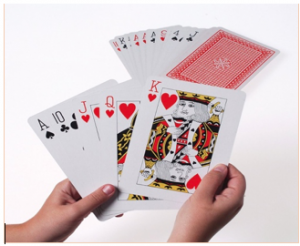After introducing a new topic in mathematics, students find it difficult to take what they have learned into practice. However, keeping students interested, active, and engaged in different activities makes a significant difference in their learning experience.
Students will come up with measures of chance. One of the questions that they can ask themselves is, “how can I quantify how likely an event is?” In this case, teachers can introduce this classic activity, using a standard deck of cards. Using a deck of cards provides a concrete look at probability and chance in a hands-on math activity. A typical deck of cards has four suits of thirteen cards in each suit, twelve face cards, four aces, twenty-six red cards and twenty-six black cards. Considering this, different probability questions can be asked to practice using this concept.
After introducing probability to your students, you can incorporate this activity within your lesson. Based on what they know about a standard deck of cards, students can answer questions, for instance, if you select one card randomly, what is the probability it is a heart?
(+) Weigh the possible outcomes of a decision by assigning probabilities to payoff values and finding expected values.
CCSS.MATH.CONTENT.HSS.MD.B.7
(+) Analyze decisions and strategies using probability concepts (e.g., product testing, medical testing, pulling a hockey goalie at the end of a game).
Allowing students to use the deck of cards to answer probability questions will help them reinforce their understanding. They will analyze and find strategies to know the probability of the specific card. This activity allows students to interact with their peers and reinforce their mathematical thinking of finding the probability of a certain card.

Hello,
For your picture problem, because your chosen Common Core Standard and the concept of cards both cover such a wide spectrum, you can really dive into all realms of probability. For instance, taking a game of poker: If a student has two “fours” and two “sevens”, what is the probability that they will get a “full house” given that one “four” is already in the discard pile?
From your example and the one I just provided, the concept of card probability can become increasingly more intricate as more factors are introduced. Thank you.